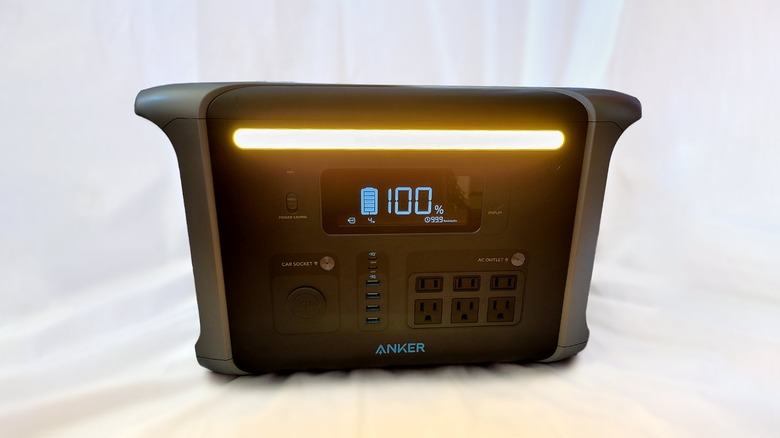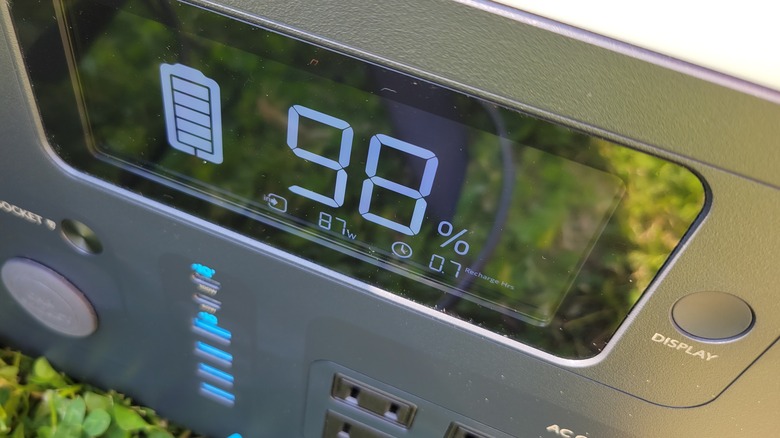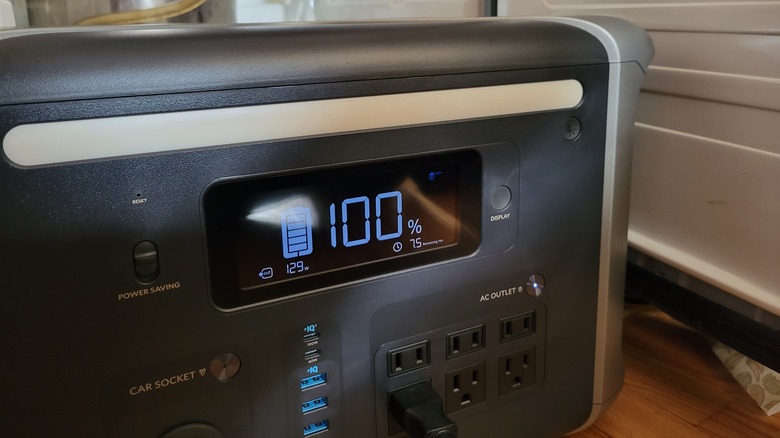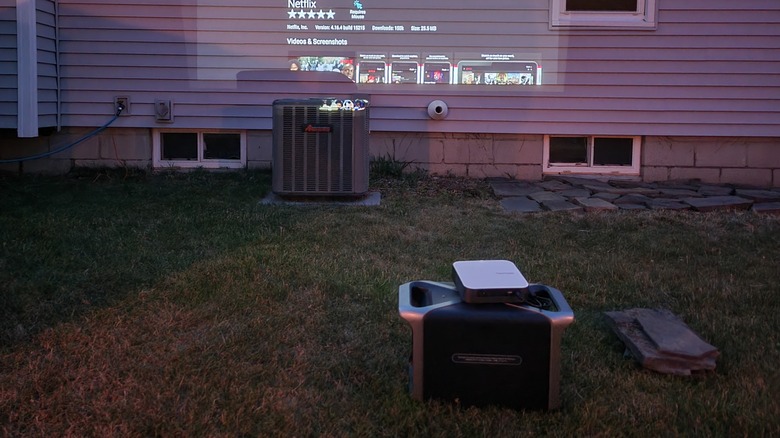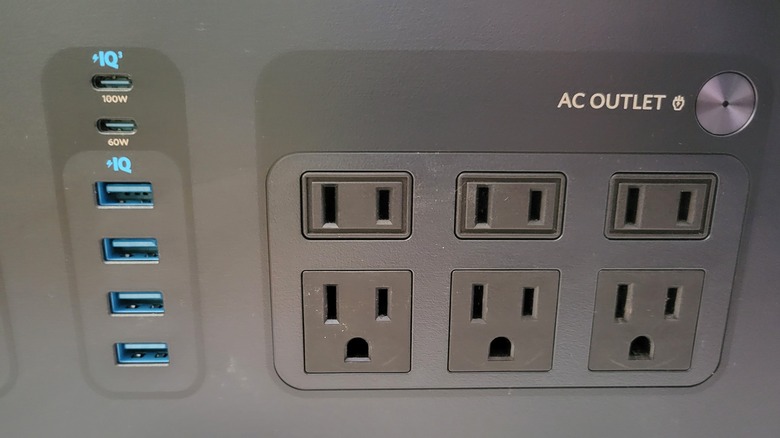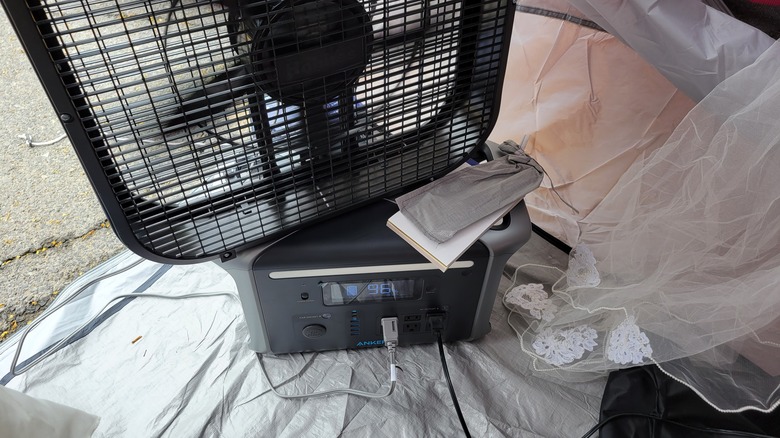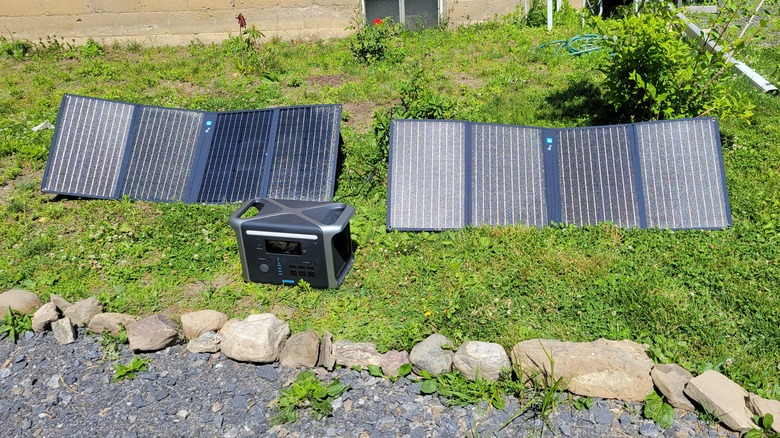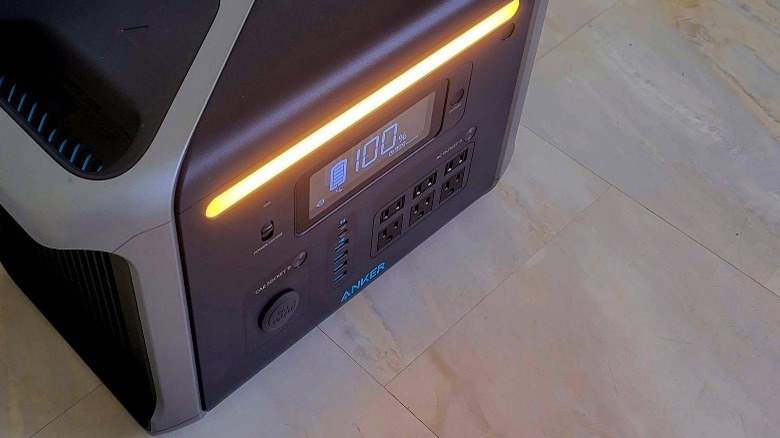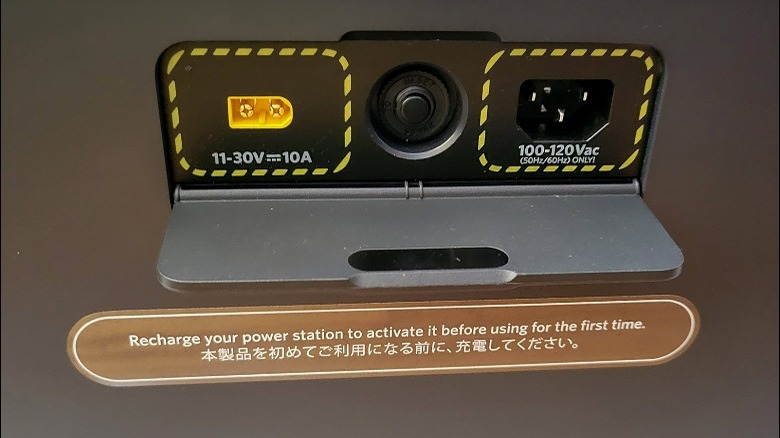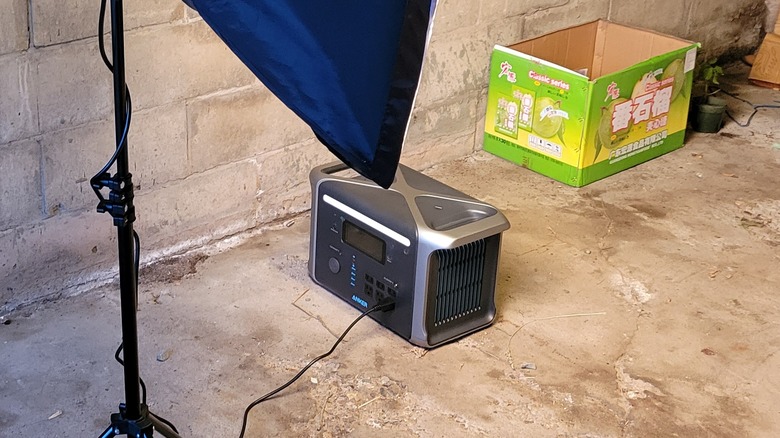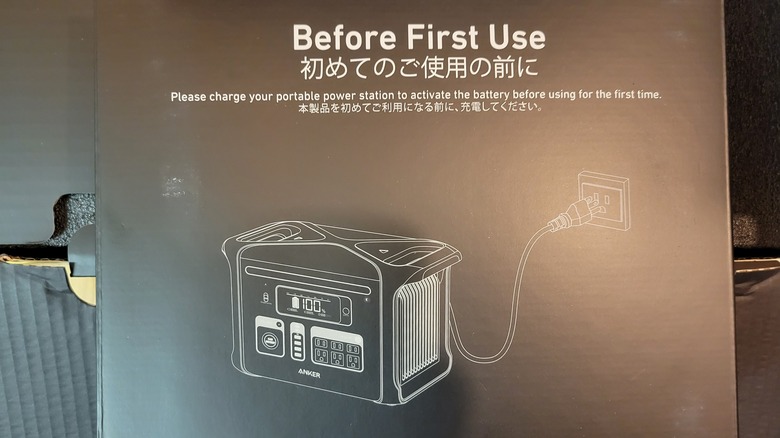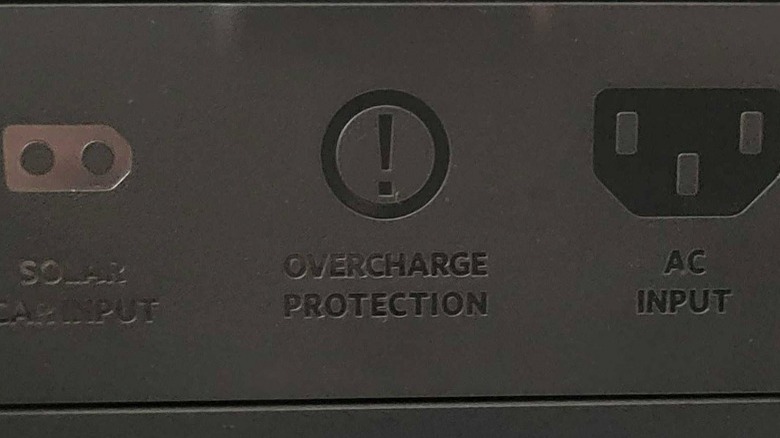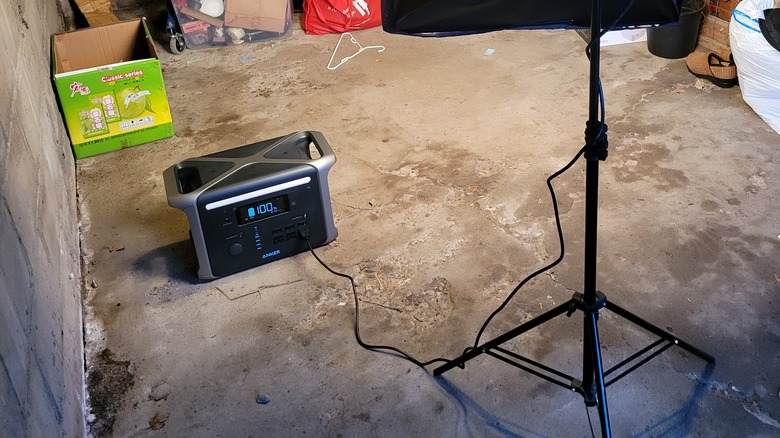Anker 757 PowerHouse Review: A Short Life Well Lived
- Lightning fast charging
- Enough power for large appliances
- Can be used as a solar generator
- Useful in a variety of situations
- Very expensive
- First review unit failed (second did not)
When it comes to portable power sources, you have plenty of options. There are traditional generators that run on fossil fuels, then there are solar generators that turn daylight into free power, and there are portable power stations which are basically just big batteries that you charge up beforehand. Anker's flagship 757 PowerHouse is the latter, though it can be transformed into a solar generator if you purchase a few solar panels. A direct comparison with gas generators is a bit unfair, as the fossil fuel option lasts as long as you have fuel. But the portable power station can be a viable alternative, or even a better option, in a few scenarios.
Anker has launched a high-end portable power station that promises lightning-fast charging with enough capacity to provide hours of power that'll keep even the most demanding appliances running. I spent a few months testing it out in a variety of environments and thought it was brilliant — until it wasn't. Anker says its new portable power station has a lifespan of 10 years and is guaranteed to last five. That guarantee is pretty handy as the one I was reviewing had a fairly significant failure after just a few short weeks of use. We'll get to how that happened shortly, but first, let's see why the 757 PowerHouse might be worth the $1,400 Anker is charging for it.
Fast charging has your back
Forward planning is an issue for many people, myself included. Luckily, the Anker 757 PowerHouse seems to be designed to make the lives of spontaneous idiots a lot easier. The company claims you can get an 80% charge on the PowerHouse in as little as an hour, while 100% takes just 90 minutes. This is due to the "Hyperflash" charging technology the Chinese company has implemented — and is one of the 757's key selling points.
Nothing I have experienced during my time with the 757 PowerHouse casts any doubt on these claims. Half the time I have needed to use it for something, it's either been on short notice, or I'd forgotten until it was almost time to go. If you sound as well prepared as I am, the fast charging system is the safety net you need. You can simply plug it in as soon as you remember, and by the time you've brushed your teeth, put your shoes on, and packed everything else in the car, a significant amount of electricity will have made its way into your portable power station.
A shocking amount of power for a portable power station
While gas generators will last for as long as you can supply them with fuel, portable power stations like the 757 operate with some limitations. You have to pre-charge them or hook them up to a solar panel, and the amount of energy those batteries store is limited, as is the amount they can expel at one time. The 757 PowerHouse seems to push at the limitations of what portable power stations can do. A quick charge will provide you with a staggering amount of power.
The power can keep something like a TV going for nine hours, or a very large appliance like your fridge/freezer going for at least two hours. While two hours may not seem like a lot, a fridge can already maintain safe food storage temperatures for around a day if the power goes out, while a freezer can stay cold for two. A little bit of time plugged into the 757 cools things down again and extends that window.
Those two hours, properly timed, could stop all of the food in your fridge and freezer from spoiling if you're unlucky enough to suffer a long-term power outage. Fast charging also plays into this as friends or family with working power can get your 757 back to full in just over an hour. A fully charged PowerHouse can also keep my Kegerator — which is essentially a mini fridge — going for seven and a half hours. So there's a good chance one of these will get your groceries through all but the worst outages.
Great for gatherings
You can also use it to cook. The 757 can keep a hotplate going for around an hour, depending on what you're cooking and how hot you need things. Something like a crockpot lasts even longer, so you can use your power station to keep soup warm at a family outing. It's good for slightly weirder events too. If you want to take a karaoke setup on the road, a 757 has enough to power a reasonably sized setup for a few hours, and can then be recharged quickly while the MC takes a break.
In terms of non-emergency applications, the 757 is outstanding. One of the highlights of my time with it involved plugging in a projector and Nintendo Switch. A large group of us were able to enjoy several hours of Mario Kart and watch a couple of things on Netflix without putting much of a dent in the 757's reserves. If needed, it could have lasted all day. The only limitation was the fact we were projecting onto the side of a house and had to wait for the sun to go away, and the 757 couldn't do anything about that.
You need one of these more than you think you do
Normally, when I get a review unit, I often have a few weeks to work out how it can be used by a variety of people in numerous scenarios. This usually means I sit and think of several situations where it might be useful and essentially go through a checklist. I didn't really need to do this with the Anker 757 PowerHouse, as I just found myself using it all the time. I've tried to include a wide variety of experiences in this review, but if none of them apply to you don't be put off. It is really one of those objects that just constantly makes itself useful somehow.
When it isn't being used for a specific purpose, it sits at the end of my couch. My couch is placed in a power outlet desert, but I can use the 757 PowerHouse to charge my phone or laptop without trailing a cable across the floor. If I'm working remotely and the weather looks good, I can sit outside at a cafe without worrying about a lack of power outlets. I just bring the portable power station.
It's like having a multitool on your belt. There will be moments in your day where you think, "the 757 PowerHouse will be perfect for this," and so you'll go get it, and it will do its job perfectly. In addition to the six AC outlets, you get four USB Type-A outlets, two USB-C outlets, and a "car socket," so you'll rarely be looking for a place to plug things in as well.
An Anker 757 PowerHouse will make you popular
If you own one of these, it won't just be you using it. You'll be helping your friends and family out with it too. Once someone you know knows that you have it and sees the application, that's it. You're going to be bombarded with messages from people who want to borrow it for various events. While that might be annoying, it's great news when you're reviewing something like the 757 Power station. Not only did I get to test a whole bunch of scenarios that I wouldn't normally encounter, but I also got a fair bit of feedback on the unit itself.
I write about tech for a living, so I might be better with it than my 76-year-old father-in-law, or my wife who isn't that interested in it. It isn't impressive that I found a device like this easy to use. The impressive bit, here, was that everyone who used the 757 PowerHouse while I was conducting this review did so with little or no instructions from me, no manual, and had no problems.
There's also a chance it can give your business a boost. I was talked into helping the Mrs. with a vintage clothing meetup, and the 757 gave her booth a bit of an edge. On a hot, stuffy, day it was the only one with a functioning fan, and customers could also charge their phones there. The event lasted several hours, and the 757 had plenty of juice left at the end of it.
You can turn it into a solar generator
The 757 PowerHouse pairs well with Anker's 625 solar panels, and they sent me a couple to use with it. At noon in the middle of summer, with a completely clear sky and a single panel in an optimal position, I only got 83W. A few weeks later, Anker sent me a second panel and the performance was pretty similar. Both panels managed to produce just over 160 Watts between them. Results will vary depending on where you are in the world, the time of year, and how clear the sky is.
One thing remains the same everywhere though, "up to 100 W" means that's the most you'll get from each panel. While you could use the panels to put some charge into your power station, it will probably take a while. Anker estimates three panels providing their maximum output will get the power station up to 80% charge in just over three and a half hours. With two panels and the 80% efficiency I got, you're looking at around five hours to hit the 80% mark and the best part of a day for a full charge. The sun doesn't stay in the same spot either, so expect to make regular adjustments to the panel's positions.
All in all, using the solar panels to recharge doesn't seem worth the effort unless you're desperate. However, they aren't completely useless. 160W isn't an insignificant amount of power. With it, you can run two or more ordinary laptops or one fairly hefty gaming laptop. You can also charge phones and tablets without tapping into your power station's reserves. You could even power a TV and games console with that kind of wattage.
It's alright for glamping, bad for camping
While I'm sure Anker has done all it can to keep the weight down on the 757, you can't change the fact it's basically a massive battery and batteries are heavy. The 757 PowerHouse weighs just under 45 pounds, which makes it portable but not something you can carry an extreme distance. So while it could provide plenty of power for a comfortable camping trip, you're probably better off sticking to car camping if you're bringing the 757 along. Lugging this over several miles of rough terrain with another 30 pounds of kit on your back is possible, but would be pretty unpleasant.
There's enough juice in the 757 to power a small 50W cooler for a day. A couple of solar panels and some luck with the weather is enough to get a weekend out of the power station with a cooler, lights, and a couple of smartphones attached. However, those solar panels aren't light either, so actually going into the woods with the power station becomes even more impractical.
Through charging offers an extra dimension
If there's something you own that you really need to keep powered 24/7, you can use the 757's through charging feature to provide a pretty stable safety net. Similar devices designed purely for this purpose have been around for a while and are known as uninterrupted power supplies. They are most commonly plugged in between a modem and/or router and the wall, and people buy them to increase their chances of having an internet connection during something like a power outage. The 757 can be used for the same purpose, but it has a lot more power than a standard UIP. As a result, you can either use it to guarantee something like a modem stays on no matter what, or use it as a safety net for bigger more power-hungry objects.
Another benefit of through charging is the fact you don't have to lose a plug when your power station is recharging. If anything, you gain a few. Depending on what's plugged in, this may slow the 757's recharge cycle down a bit, but you could plug most household objects into it. If your home has a shortage of outlets and you absolutely need to charge the 757, then plugging it into the TV's slot, then the TV into the power station, is completely viable.
An ideal backup for apartment dwellers
As someone who lives in an apartment, I can verify it does severely limit your options when it comes to getting through power outages. A conventional or inverter generator is completely out of the question as I don't want to die along with everyone else on my floor. So that limits the options to battery banks and portable power stations. I would argue the 757 Power Station is worth buying for this reason alone. Outages happen all the time too, and a bad storm could leave you without power for days.
If a storm looks bad I can top up the charge in minutes. A full Power Station is enough to keep every cell phone in my house going through days of intense use, get my modem back up and running, and power a laptop, TV, or projector. You can run large appliances like refrigerators and freezers with the 757. If you're smart, you'll note that the FDA says a fridge with no power can keep food cold for four hours, and a full freezer will stay cold for up to 48. Theoretically, you could use the power you have stored in the 757 in ten-minute bursts every couple of hours to drop your fridge's temperature and keep food safe and fresh throughout a long power outage. You can also drive it to a friend's house, hang out for an hour, and bring an 80% charge back with you. Then there are the solar panels, which may not be enough to power your house but can either through-charge up to 300 Watts worth of essentials through the day or cram some vital juice into your 757 PowerHouse in a pinch.
This was amazing, and then it died on me
If the review ended here, you would be looking at a ten out of ten product and, despite the hefty price tag, I would recommend you get one without hesitation. However, my time with the 757 didn't end well. One of the worst things a review unit can do is die on you, with perhaps the only worse scenario being the unit causing you some kind of physical harm. The unit I was sent didn't hurt anything but my feelings, and it didn't even die in a spectacular manner.
One of my wife's friends asked if she could borrow it (because people will hound you for this thing) and I said, "yeah, no problem." I checked if the unit was fully charged first, and it appeared to be out of battery despite me being quite sure it should have had at least 70%. Still, this wasn't an issue and I plugged it into the wall thinking the fast charging system would have it back up to full in no time. Unfortunately, it stayed at 0% and would only draw about 5 watts from the wall. Leaving it on charge for over a day would get the display to read 30%, but that all disappeared the second the 757 was unplugged. The reset buttons did nothing to remedy the situation. This particular 757 was toast.
We don't know what killed it, yet
I didn't engage in any kind of destructive testing with the 757, nor did I subject it to any stresses it wasn't billed as being capable of handling. The most demanding portion of the testing period was probably when I plugged a hotplate into it and made a few pancakes, and the 757 did just fine. The failure itself came after I had used it to test the solar panels, then brought it back inside and stored it at the side of my couch for around five days. Naturally, I contacted Anker, who did their best to help out. I was sent a list of things to try which could theoretically have fixed a 757 in different circumstances, but none of them applied to my particular toasted unit. They also sent me a replacement out, which I have used a few times. The replacement has performed every bit as well as its predecessor, and is still alive and well.
The original has been sent back to Anker, who will be performing some kind of autopsy on it. When they get back to me with the results, I'll make sure to update this article with exactly what went wrong, what may have caused it, and what the chances of that thing happening are.
On balance, I'd still probably buy one
The fact this review doesn't end with "it died on me for no reason, 1/10" might illustrate how staggeringly good these portable power stations are. The failure itself is likely a freak occurrence. Anker back their 757s with a five-year guarantee, and having to ship a replacement out every few months doesn't make good business sense. Then again, it did fail catastrophically, and if I was keeping one of these in a cupboard for emergency use the fact it could let me down when I actually need it is a bit unsettling. A guaranteed replacement is nice, but you may not have time to wait for it to ship when you actually need it.
On reflection, this wasn't an emergency use object, and I would still have one of these. It's far better than any other portable power station I've encountered, and as I'm an apartment dweller a traditional generator is not an option. If it hadn't kicked the bucket, it would have been a solid 10, and the small amount of uncertainty I now have regarding its reliability doesn't pull the final score down too much. Get yourself an Anker 757 PowerHouse, but make sure you keep hold of the warranty paperwork and keep a plan B ready if disaster strikes. The Anker 757 PowerHouse will cost you approximately $1,399.99 from a variety of retailers right now.
